Åre
This is the sighted version that was marked on October 27, 2020. There is 1 pending change that needs to be sighted.
![]()
This article is about the place Åre; for the Swedish municipality Åre see Åre (municipality).
Åre [ˈoːre] is a locality (tätort) in the Swedish province of Jämtlands län and the historical province of Jämtland. It is located about 97 kilometres (97 mi) northwest of Östersund in the municipality of the same name, but is not its main town. Åre lies at the foot of the 1420-metre-high mountain Åreskutan. A funicular railway from 1910 as well as aerial tramways, gondola lifts and ski lifts provide access to the ski area, which is one of the oldest and most important in Sweden. The village lies on the Indalsälven, which widens into a lake here.
Åre's neighbouring villages to the east are Björnänge and Undersåker. Duved, to the west, has been part of the Åre Tatort since 2015, after the villages have gradually grown together through the development of the intervening residential and holiday home areas such as Ullån, Kläppen, Ängena, Tegefjäll and Tegefors.
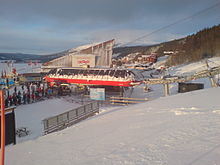
Bottom station in Åre

Kabinbanan
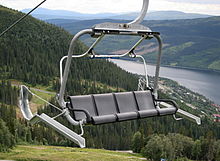
Hummellift with bicycle holder
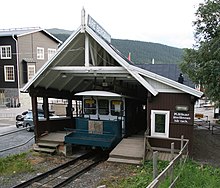
Mountain banana valley station
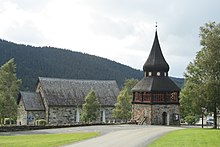
Åre church
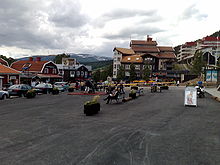
Centre of Åre

Åre with lake Åre
Tourism development
The first travellers came to Åre as early as the 12th century AD. These tourists were pilgrims going to the grave of St. Olav in Trondheim (then: Nidaros).
Åre was initially a farming village until tourism began with the completion of Mittbanan in 1882. The first tourists belonged to the more educated class; among them were many professors, doctors, architects and students. They came mainly in the summer and stayed on farms. Among other things, they were interested in botany and sought out the rare plants of the fells for their herbaria.
In 1895 the first major hotel was built in Åre.
In 1906 there was a proposal to build a mountain railway (Swedish: Bergbanan) from Åre to the top of Åreskutan. The planned route was from Åre Torg (square) via Östra Platån and Mörvikshummeln to the summit. However, the route was only realised as far as Östra Platån (by Hotell Fjällgården) and was built from 1908 by von Roll/Habegger at a cost of 230,000 sKr and opened on 7 March 1910. Of all the lifts, only the Åre Bergbana(n) starts from the historic town centre west of the main road. This funicular railway has a length of 790 m and a gauge of 1067 mm (3 ft. 6 in.), running from an altitude of 398 m up to 556 m. The line has one track with an Abt switch - also the middle station - and a 15° left turn slightly above. The rope from the (left) light blue to the red car is electrically driven at the deflection pulley at the top since a long time. Each car holds a total of 60 people in 3 tiered cabins or compartments. With a speed of 2,1 m/s and a running time of 6:50 minutes up to 400 persons/hour can be transported in each direction.
Since 22 August 2008, Bergbanan and the path connecting the bottom station to the old railway station in the village have been listed as a historical monument (byggnadsminne) and are still in operation. In the beginning, there was also a bobsleigh track next to the tracks of Bergbanan. The Bergbanan brought winter sports to Åre and the number of hotels and tourists increased. However, most tourists were still the botanically interested summer tourists.
In 1918 Åre got electricity.
Sweden's first ski lift, the Lundgårdslift, was opened in Åre on 6 January 1940. The Lundgårdslift was located in the area of today's ski lift VM 8. The Lundgårdslift was the first alternative to Bergbanan to get to Åreskutan. It was in operation until 1965.
In 1952 the ski lifts to Mörvikshummeln were built. This made Åre more interesting for winter sports tourists, as only a few places in Sweden had ski lifts at that time.
In 1954, the Alpine World Ski Championships were held in Åre. This marked a turning point for tourism, as from then on more winter than summer tourists came. These new tourists lacked the interest of the earlier tourists for the peace and quiet of the fells. They also no longer wanted to climb the mountains, but instead quickly ski back down.
Between 1954 and 1970, there was almost no further development in Åre and other places like Duved caught up in the tourists' favour, as it was quieter here compared to Åre. However, Åre remained the largest winter sports resort in Sweden.
From 1970 to about 1990 there was a strong development of Åre. This includes lifts, hotels and discos. During this period, the main road (E14) was extended and relocated, dividing the town into two parts. Today, two ski slopes and a ski lift cross over and under the E14, which separates a large part of the town from its ski area. In 1975, the Swedish government decided to develop recreational areas, which included tourism. Åre also benefited from this program, as the state provided money for the development of infrastructure, including ski lifts. Part of this programme was the construction of the Kabinbanan in 1976, which takes you up to 1274 metres of the 1420.10 metre high Åreskutan. The Kabinbanan rides on 60-metre-high masts designed for wind speeds of more than 70 m/s. In the early 1980s, the Björnen/Björnänge ski area was expanded and in 1985 the Störtloppet downhill slope was opened in Åre, where World Cup races are still held today. The slope was designed by Bernhard Russi, a Swiss designer of downhill slopes. The highest jump on this slope, the Russi jump, was named after him.
In the 1990s there were problems in the Swedish real estate market, which also affected Åre. An additional problem during this period was that there were three winters with very little snow in a row and a hurricane destroyed parts of the lift system. As a consequence of these problems, on the one hand the capacity of the snow cannons was increased in order to extend the ski season. Secondly, a management organisation for tourism in the Åre ski area, Årefjäll AB, was established. Årefjäll AB consisted of the villages in the ski area, the lift operators and a bus company in the region. Later, Årefjäll AB was bought by Skistar AB, which still (February 2019) operates the ski lifts and rents out many holiday apartments and hotel rooms.
At the end of the 1990s there were thoughts about how summer tourism in Åre could also be developed again. And so the mountain was made accessible for mountain bikes. In this context, the Mountain Bike World Championships were held in Åre in 1999. Currently (2013) seven chairlifts and gondolas are open in summer for mountain bikers and their bikes.
Infrastructure
Åre is located on the European Road 14 between Östersund and Trondheim. Åre has a railway station on the Sundsvall-Storlien railway line, from which there are regular train connections to Östersund, Trondheim, Stockholm and southern Sweden. The station was renovated for the 2007 World Alpine Ski Championships.
Search within the encyclopedia